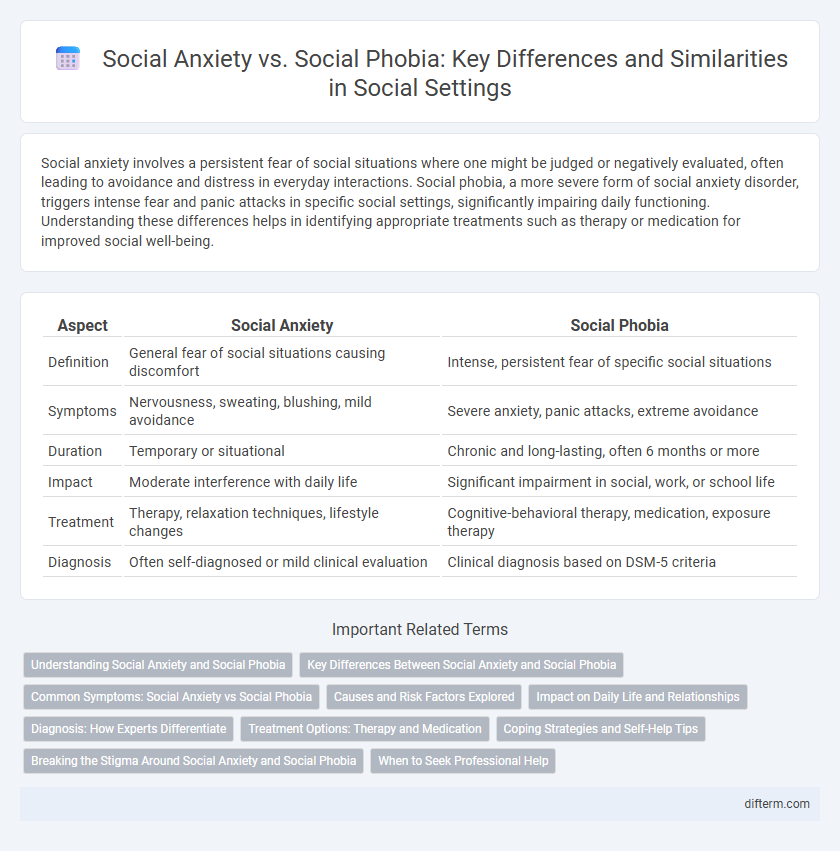Social anxiety involves a persistent fear of social situations where one might be judged or negatively evaluated, often leading to avoidance and distress in everyday interactions. Social phobia, a more severe form of social anxiety disorder, triggers intense fear and panic attacks in specific social settings, significantly impairing daily functioning. Understanding these differences helps in identifying appropriate treatments such as therapy or medication for improved social well-being.
Table of Comparison
| Aspect | Social Anxiety | Social Phobia |
|---|---|---|
| Definition | General fear of social situations causing discomfort | Intense, persistent fear of specific social situations |
| Symptoms | Nervousness, sweating, blushing, mild avoidance | Severe anxiety, panic attacks, extreme avoidance |
| Duration | Temporary or situational | Chronic and long-lasting, often 6 months or more |
| Impact | Moderate interference with daily life | Significant impairment in social, work, or school life |
| Treatment | Therapy, relaxation techniques, lifestyle changes | Cognitive-behavioral therapy, medication, exposure therapy |
| Diagnosis | Often self-diagnosed or mild clinical evaluation | Clinical diagnosis based on DSM-5 criteria |
Understanding Social Anxiety and Social Phobia
Social anxiety involves a persistent fear of social situations where one may be judged or scrutinized, often causing discomfort and avoidance behaviors. Social phobia, a more severe form of social anxiety disorder, leads to intense fear that disrupts daily functioning and relationships. Recognizing the differences between these conditions is essential for effective diagnosis and treatment strategies.
Key Differences Between Social Anxiety and Social Phobia
Social anxiety primarily involves fear of social situations and potential judgment, leading to discomfort and avoidance behaviors, whereas social phobia represents a more intense, persistent fear characterized by extreme avoidance that significantly impairs daily functioning. Social anxiety symptoms include nervousness, self-consciousness, and worry, while social phobia often entails physical symptoms such as rapid heartbeat, sweating, and panic attacks during social interactions. The severity, duration, and impact on personal and professional life are key differentiators, with social phobia being classified as a clinical disorder under anxiety disorders in DSM-5.
Common Symptoms: Social Anxiety vs Social Phobia
Common symptoms of social anxiety include intense fear of social situations, excessive self-consciousness, and avoidance of social interactions. Social phobia, a more severe form of social anxiety disorder, presents with extreme fear of being judged, physical symptoms like sweating and trembling, and significant disruption to daily life. Both conditions involve anxiety related to social settings, but social phobia impacts functionality to a greater extent.
Causes and Risk Factors Explored
Social anxiety and social phobia share overlapping causes rooted in genetic predisposition, brain chemistry imbalances, and environmental influences such as traumatic social experiences or overprotective parenting. Risk factors include a family history of anxiety disorders, early negative social encounters, and chronic stress exposure, which amplify susceptibility. Neurobiological studies highlight alterations in the amygdala's response to social stimuli as a core contributor to both conditions.
Impact on Daily Life and Relationships
Social anxiety and social phobia significantly impair daily functioning and interpersonal relationships by causing intense fear and avoidance of social situations. Individuals may experience difficulty maintaining friendships, performing at work, or attending social events due to overwhelming anxiety symptoms such as sweating, trembling, and rapid heartbeat. The persistent fear of judgment or embarrassment often leads to isolation, reduced self-esteem, and challenges in forming healthy, supportive connections.
Diagnosis: How Experts Differentiate
Experts differentiate social anxiety from social phobia primarily through the intensity and duration of symptoms, with social phobia presenting more severe and persistent fear of social situations. Diagnosis involves evaluating criteria from the DSM-5, focusing on significant distress or impairment caused by the disorder. Clinical assessments include patient history, symptom checklists, and sometimes rating scales like the Liebowitz Social Anxiety Scale to determine the diagnosis accurately.
Treatment Options: Therapy and Medication
Cognitive-behavioral therapy (CBT) remains the most effective treatment option for both social anxiety and social phobia, targeting negative thought patterns and improving social skills. Selective serotonin reuptake inhibitors (SSRIs) and serotonin-norepinephrine reuptake inhibitors (SNRIs) are commonly prescribed medications that help reduce symptoms by balancing neurotransmitters. Combining therapy with medication often enhances outcomes, particularly in severe cases where social avoidance impairs daily functioning.
Coping Strategies and Self-Help Tips
Coping strategies for social anxiety emphasize gradual exposure to social situations and cognitive-behavioral techniques to reduce negative self-talk and fear. Self-help tips include practicing mindfulness, breathing exercises, and building social skills through group activities or support networks. Differentiating social anxiety from social phobia is crucial, as social phobia often requires professional intervention alongside self-help methods.
Breaking the Stigma Around Social Anxiety and Social Phobia
Breaking the stigma around social anxiety and social phobia requires widespread education that clarifies these conditions as legitimate mental health disorders, not mere shyness or personal weakness. Promoting awareness through evidence-based resources and personal testimonies encourages empathy and understanding, reducing discrimination and social isolation. Increasing access to professional treatment options, such as cognitive-behavioral therapy and medication, supports individuals in managing symptoms and leads to improved social functioning and quality of life.
When to Seek Professional Help
Seek professional help for social anxiety or social phobia if intense fear or avoidance of social situations interferes with daily functioning, such as work, school, or relationships. Persistent symptoms lasting six months or more, including physical distress like rapid heartbeat, sweating, or trembling in social settings, indicate the need for evaluation by a mental health professional. Early intervention with cognitive-behavioral therapy or medication can significantly improve outcomes and prevent worsening symptoms.
social anxiety vs social phobia Infographic

 difterm.com
difterm.com